SKT Smart Home: Tale of two smart plugs (Witty & Dawon)
Posted by Wesley on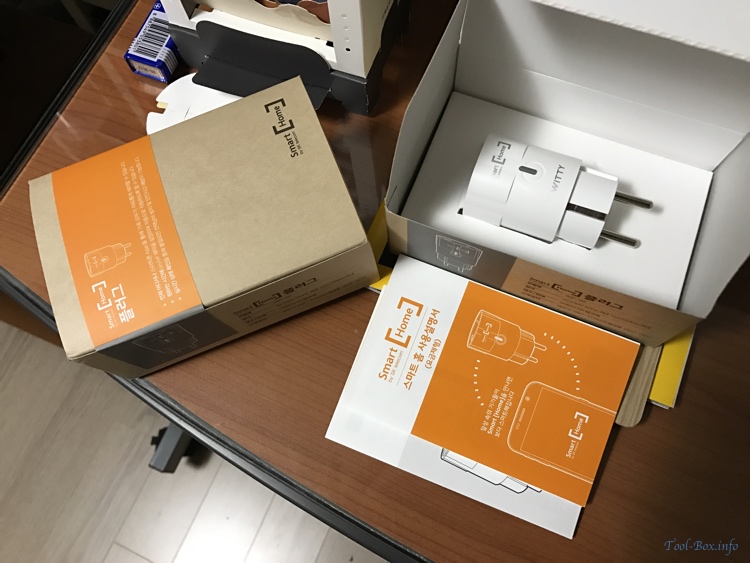
Smart Plug "Witty E" WIP-02A, unboxed
Lots of companies are hopping on the wave of Internet of Things (IoT) these days, each trying to build an ecosystem of their own. Major Korean mobile carriers (SK Telecom(SKT), KT, and LGU+) are no different, each setting up proprietary efforts. I used to largely ignore them because they required monthly fee, ranging from a few dollars per device to tens of dollars for "unlimited" (discounted with multi-year contract). With many non-carrier solutions usable without fees, I felt this to be undesirable.
However, SKT must have felt that this arrangement was hurting their chances for wide acceptance, because it began offering some of their affiliated products free of monthly fees, charging only a nominal (KRW 5,500, US$4.80) one-time fee included in the sales price since last October. I decided to take the bait and started integrating their home IoT products, sold under the "SKT Smart Home" brand, into my house. The very first one was a smart plug. The one you see here is the one made by Witty.
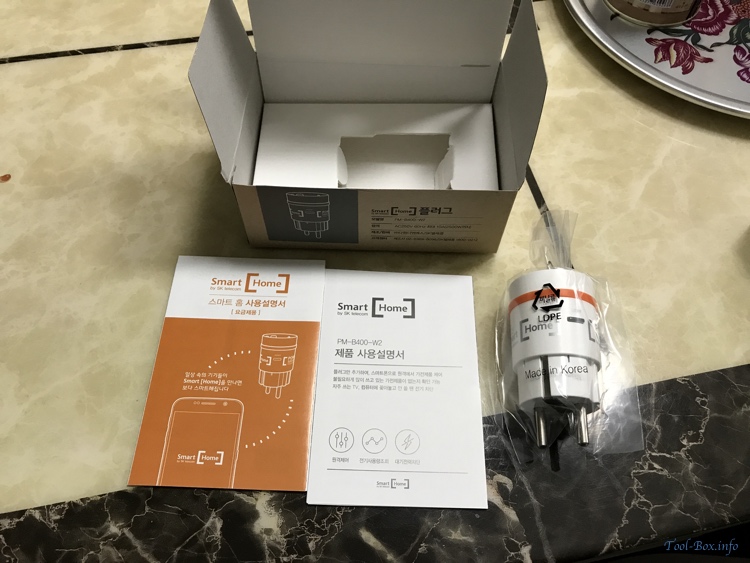
Smart Plug "Dawon Power Manager" PM-B400-W2
Over time, I installed several of these plugs around the house and some of them came from another company, Dawon DNS. Because SKT was selling them, lots of things were made to be nearly identical, namely the packaging and the functionality. The frugal-looking brown paper boxes contain the plug and the instruction manuals, all of which look almost exactly the same except for the diagram of the plug. Both companies' plugs are controlled by the one and the same official app, and works largely like as if they are the same product.
Even the price is similar, at around $22.50 to $26, which makes them one of the most inexpensive options. This includes the aforementioned fee, so the pricing is rather aggressive. The deal is made even sweeter by the fact that the plugs do not need any gateways or hubs to operate as some other solutions do (namely that of other carriers'). It will interface directly via Wi-Fi, so if you already have a wireless router at home there's no additional cost involved.
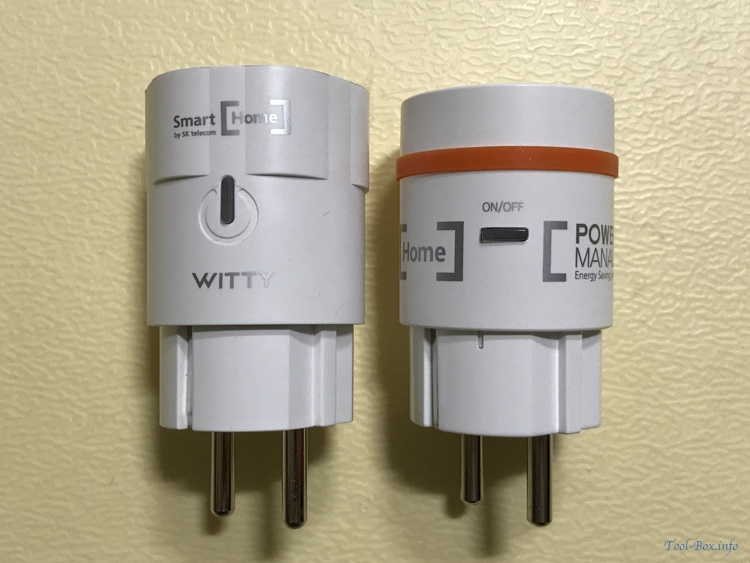
Witty E and Dawon Power Manager, side by side
Of course, there were some interesting differences like the shape of the plug, featuring each company's unique design. The one from Dawon is slightly shorter, although it makes little difference once something is plugged in. The main switch on the side turns red for both plugs when it's off, while it turns blue for Witty and green for Dawon when it's on.
You hear a click typical of a relay when you press the switch, as it needs to control the flow of power up to 2200W (220V, 10A). This should be good enough for most devices except some high-powered air conditioners. The plug will automatically shut down when over-current is detected, so it should be good for finding out if, say, the air conditioner is overworked due to obstructed outside fan.
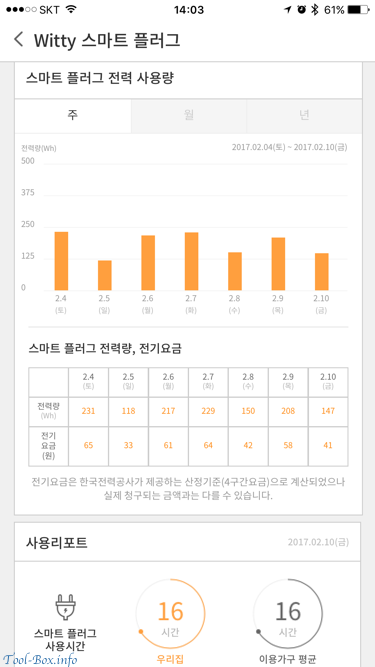
Daily power consumption data recorded by a smart plug
As mentioned earlier, both plugs work with the official SKT Smart Home app, available on both iOS and Android OS. If you're a first time user, you have to register as a member first even if you're a current SKT customer because the platform is carrier-agnostic. Once logged in, you go through a 4-step registration process for each device: connect to the home Wi-Fi network, make the device enter pairing mode, connect to the device's Wi-Fi, and initiate the registration on the server.
The core functions of the smart plugs from both companies are same and simple: it can be remotely turned on or off, and it can measure how much power is consumed through it. The actual controlling and logging actions are all done via SKT's server, with the app providing the user interface. Therefore it's only as smart as the app and reliable as the server.
Luckily, the current version is good and provides: on/off program (by schedule or IFTTT-style conditions), over-usage alarm, sleep timer, long-term idle alert, and historical report (daily / weekly / monthly). You can see the last function above. Some aspects of the interface need improving, but I'm satisfied with the overall functionality. As for the server, it is mostly reliable with command failure very far and few in between. I did once see a glitch that prevented logged usage data from showing up, but a call to the customer service fixed the issue in a day.
One thing I should note for the international readers is that the app is currently very Korea-centric. Even if you set the phone's language to English, the app will only display in Korean only. Also, the time zone used for the daily report is fixed to Korea Standard Time (UT+9), probably because the managing server is located in Korea. The devices themselves will work without any problems outside the country given correct power voltage is supplied.
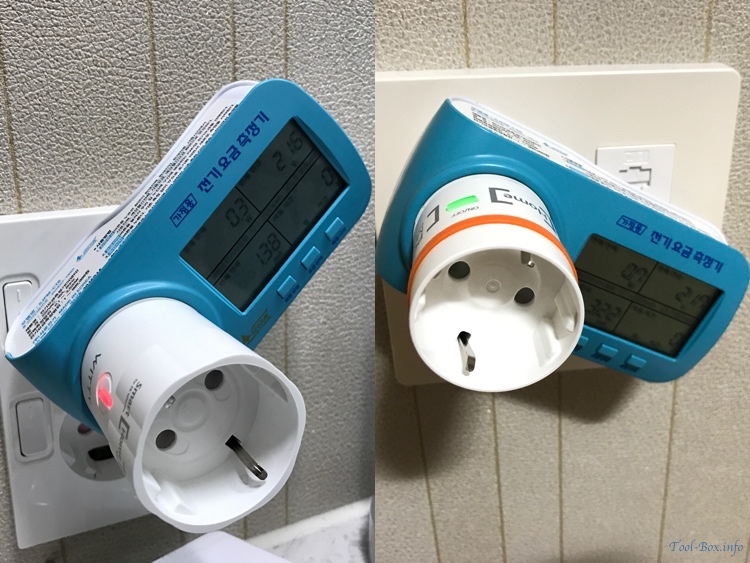
Measuring standby power consumption of the smart plugs
Because the two plugs work the same way in the app, one might think that the difference is merely aesthetics. But I found out that the underlying hardware is indeed different.
On the specification sheet, the standby power consumption of the plug are both listed to be 0.5W or less. I tested this claim as you see above and got a surprising result. Witty plug consumed 0.3W in off position and 0.6W in on position. Dawon plug did 0.7W in either. So while the Witty one came close to the claim, Dawon did not.
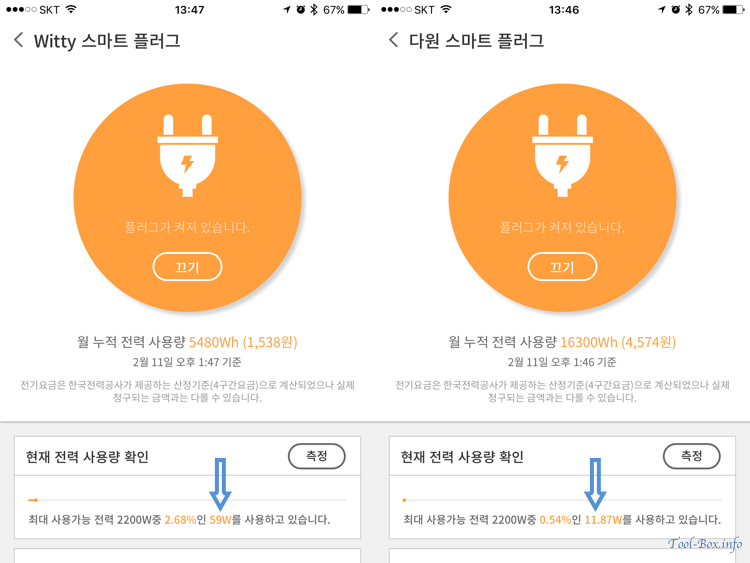
Measurement precision difference between the smart plugs (Left: Witty / Right: Dawon)
On the other hand, the Dawon plug shows the polled power consumption data with higher precision (to two decimal places) than the Witty plug (to integer). If you're dealing with devices that don't consume much power, the former may prove to be more useful.
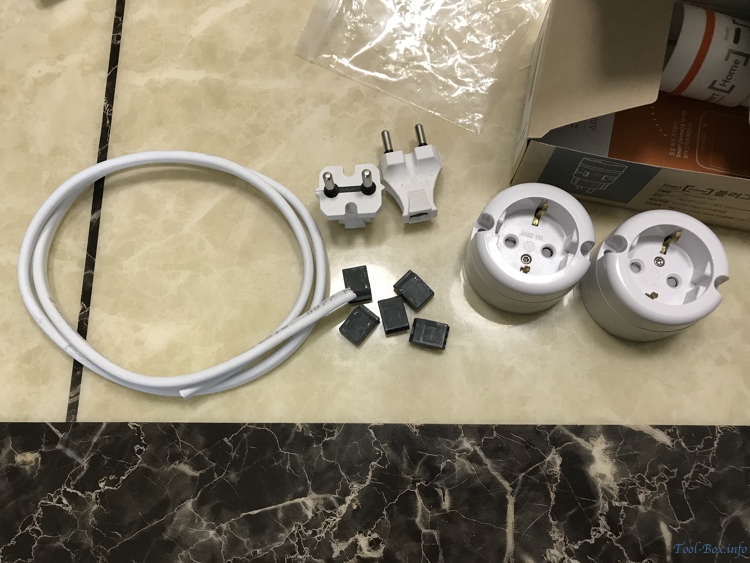
Parts for building a smart plug connection inside the distribution board
After a few months with the smart plugs, I wanted some of them to control a whole section of the house, not just a single outlet. This would be done by rerouting certain power paths from the distribution board to the plug. I identified two sections that would benefit from this arrangement - the lighting (every light in the house) and the kitchen-laundry room area. The former would let me see how much power is used for lighting every day and enable me to turn off all the lights when everyone is out of the house. The latter would provide insights into the power consumption trends of two of the major home appliances, the refrigerator and the washing machine.
I didn't want to modify the plug itself to achieve this, so I needed to devise an outlet-plug combo that hooks onto one of the circuit breakers and reroutes the power into a smart plug before letting it go to the intended destination. For this, I bought some single outlets, plugs, and wire connectors, as well as a meter of insulated 2.5SQ (2.5mm2) copper wire.
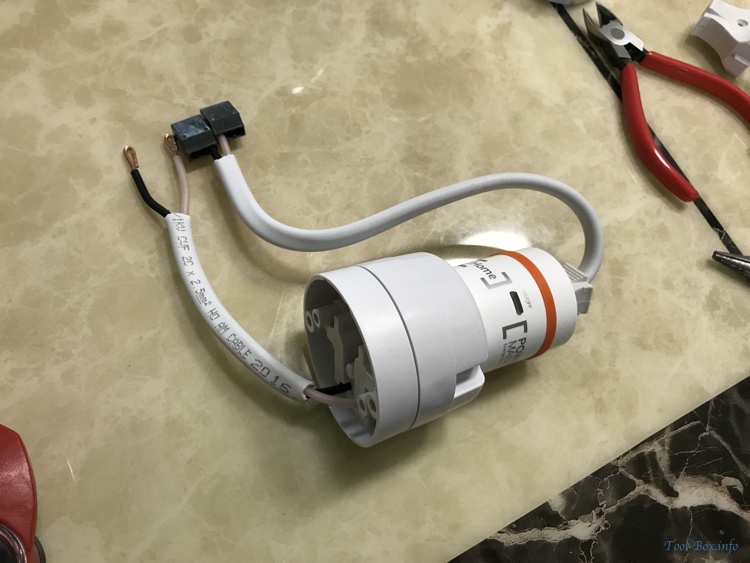
Completed distribution board connection
The materials I bought were enough to make two sets of these outlet-plug contraptions. It would be both easily installed into and removed from the distribution board by screwing/unscrewing two wires going into circuit breaker and push in/pull out two wires going out to the house. The whole process took only a couple of minutes to do. Also, the smart plug could be swapped in a few seconds if needed. As it turned out, this helped me immensely in diagnosing a problem I was about to encounter.
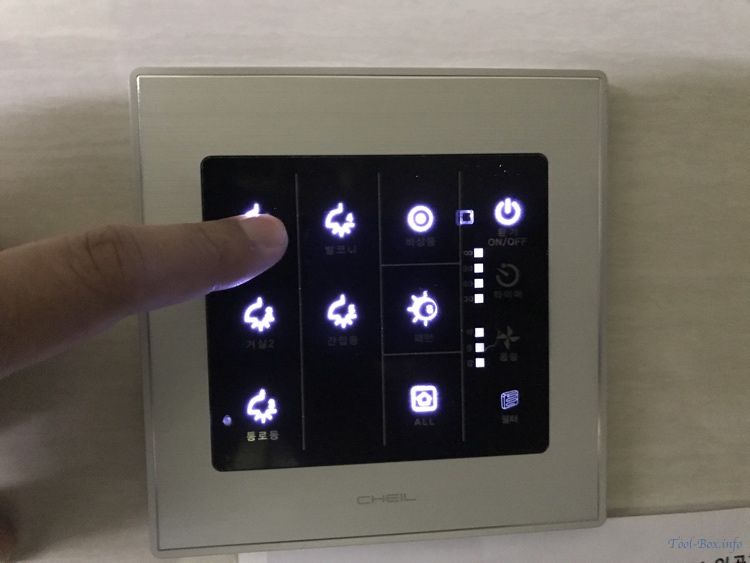
Dawon smart plug causes issues with networked lighting
Once the Dawon plug was connected to the lighting section, it didn't take me long to notice that the living room light switches were no longer functional. These switches were connected to the house's integrated home networking system and were controllable from a wall pad. Same type of switches were used in the bedroom, and while those did still function, one of the lights were dimly lit even when it was supposed to be turned off. Something was not right.
Adding a ground wire did not help and things went back to normal only by removing the Dawon plug from the circuit. I wondered if the Witty plug would be any better, so I pulled one out of an existing installation and put it into the lighting section. To my surprise, the lightings worked as intended. So it became obvious that the Dawon plug had some compatibility issues. My guess is that it's not properly handling the quiescent current required for the operation of the networked switches. It had no issues in the kitchen-laundry room section, so the one I installed there was kept in place.
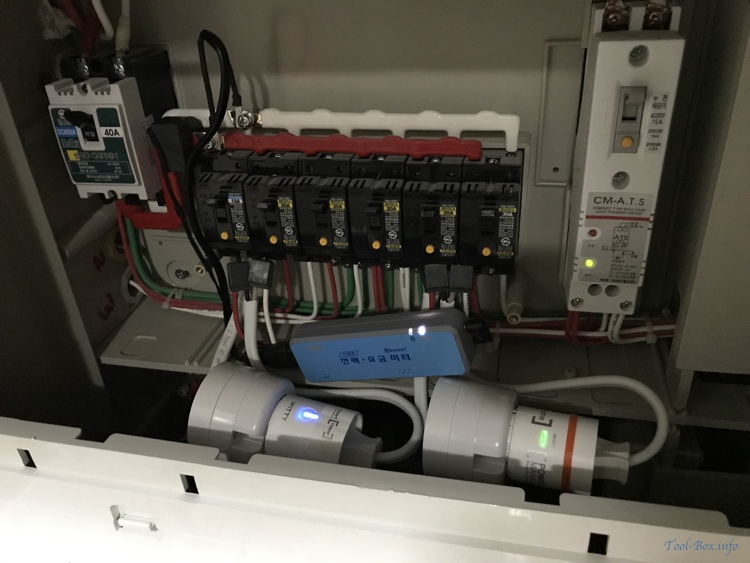
Final smart plug setup inside the distribution board
Ultimately, the distribution board's setup became looking like the above - one Witty plug, one Dawon plug, and the Seojun smart meter I installed last year hang out of it. It doesn't look too elegant, but they stay behind the panel, so it's not really a problem.
All in all, I like the convenience and the information provided by the smart plugs from the two companies. But if I need to buy another one, I will get the Witty plug owing to its lower standby power and better compatibility. I may outline some detailed use cases of these plugs later if I have the time, but my next write-up will feature another device in SKT Smart Home line-up. So stay tuned.